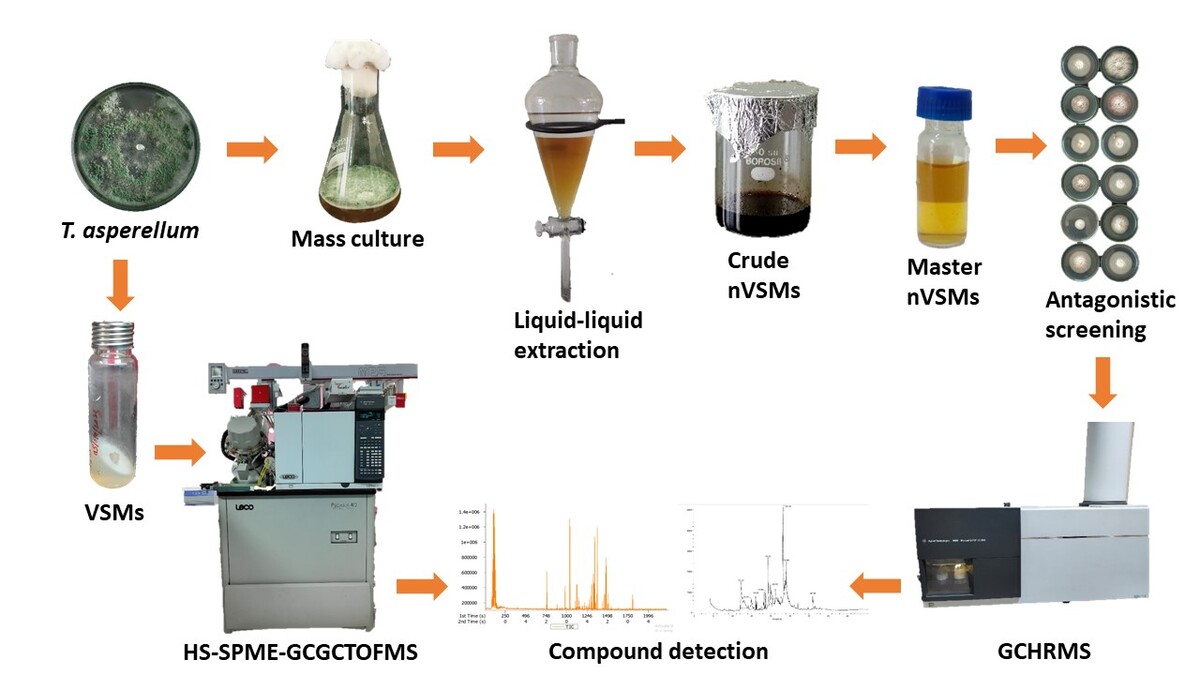ORIGINAL ARTICLE
Antagonistic profiling of Trichoderma asperellum produced volatile and non-volatile secondary metabolites towards pathogenic Fusarium oxysporum f. sp. ciceri
1
Department of Plant Pathology, Dr. Panjabrao Deshmukh Krishi Vidyapeeth, Akola, 444104, Akola, India
These authors had equal contribution to this work
A - Research concept and design; B - Collection and/or assembly of data; C - Data analysis and interpretation; D - Writing the article; E - Critical revision of the article; F - Final approval of article
Submission date: 2025-07-05
Acceptance date: 2025-09-16
Online publication date: 2025-10-29
Corresponding author
Bhushan Popat Birari
Department of Plant Pathology, Dr. Panjabrao Deshmukh Krishi Vidyapeeth, Akola, 444104, Akola, India
Department of Plant Pathology, Dr. Panjabrao Deshmukh Krishi Vidyapeeth, Akola, 444104, Akola, India
HIGHLIGHTS
- Trichoderma asperellum showed antifungal activity against F. oxysporum f. sp. ciceri
- High Inhibition by ethyl acetate extract of TaSrYa
- Antifungal compounds like 9-octadecenoic acid and dehydroacetic acid found in TaSrYa
- TaSrGa produced 67 volatile secondary metabolites
- The tested strains offer promising natural alternatives to synthetic fungicides
KEYWORDS
Trichoderma asperellumFusarium oxysporum f. sp. ciceriAntifungalnon-volatile secondary metabolitesvolatile secondary metabolites
TOPICS
ABSTRACT
Fungi of the genus Trichoderma are widely marketed as biocontrol agents against plant pathogens. However, some Trichoderma species may produce toxic secondary metabolites, underscoring the need for comprehensive safety assessments to ensure their ecological safety. In this study, the antifungal activities of volatile secondary metabolites (VSMs) and non-volatile secondary metabolites (nVSMs) produced by six Trichoderma asperellum strains (TaSrBh, TaSrYa, TaSrBu, TaSrUm, TaSrGa, and TaSrCh) were evaluated against the chickpea wilt pathogen Fusarium oxysporum f. sp. ciceri. Bioassays of VSMs and nVSMs revealed that TaSrGa and TaSrYa exhibited the strongest antifungal activity. The ethyl acetate extract of the TaSrYa strain showed excellent growth inhibition (60–100%) of F. oxysporum f. sp. ciceri, prompting further investigation into its metabolic profile. To identify potential fungicidal compounds, spectroscopic analyses were performed on the ethyl acetate extract of TaSrYa. The predominant compounds identified included 9-octadecenoic acid (26.32%), dehydroacetic acid (25.71%), 9-undecenal 2,10-dimethyl (11.31%), 7,10-octadecadienoic acid (8.62%), 9,12,15-octadecatrienoic acid 2,3-dihydroxypropyl ester (Z,Z,Z) (6.18%), and cis-Z-α-bisabolene epoxide (4.96%), which are likely responsible for inhibiting pathogen growth. Additionally, two-dimensional gas chromatography and spectroscopic analyses of volatiles from TaSrGa identified 67 VSMs, categorized as alcohols, alkanes, esters, acids, and terpenes. The examined T. asperellum strains demonstrated strong antagonistic effects against the pathogen responsible for chickpea wilt, suggesting that these biocontrol agents could be used in the formulation of natural fungicides, offering an eco-friendly alternative to synthetic fungicides.
CONFLICT OF INTEREST
The authors have declared that no conflict of interests exist.
Share
RELATED ARTICLE
We process personal data collected when visiting the website. The function of obtaining information about users and their behavior is carried out by voluntarily entered information in forms and saving cookies in end devices. Data, including cookies, are used to provide services, improve the user experience and to analyze the traffic in accordance with the Privacy policy. Data are also collected and processed by Google Analytics tool (more).
You can change cookies settings in your browser. Restricted use of cookies in the browser configuration may affect some functionalities of the website.
You can change cookies settings in your browser. Restricted use of cookies in the browser configuration may affect some functionalities of the website.




